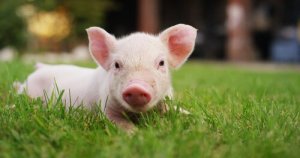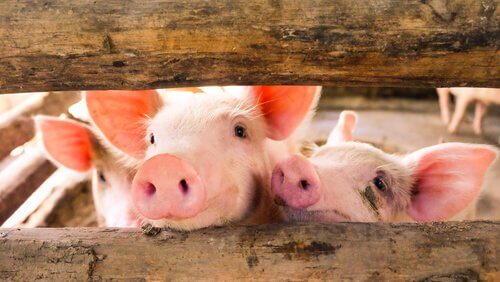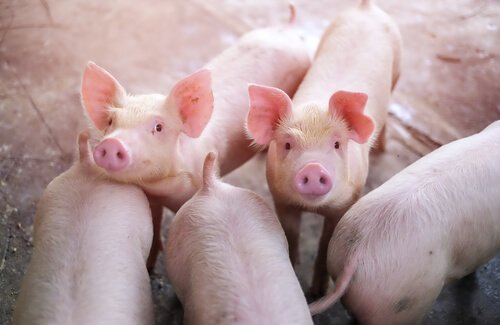The History of Pig Domestication


Written and verified by the vet Eugenio Fernández Suárez
The history of pig domestication is one of the most interesting ones among all farm animals. In fact, the relationship between pigs and man goes back thousands of years, and it’s believed that this domestication took place in two distinct regions.
Contrary to what we might believe, pigs are actually very intelligent. However, unlike many other farm animals, there isn’t an awful lot of research on them. Pigs are one of the most intelligent animals in the world, coupled with some very interesting behavior patterns. One of these is the fact that they build a type of nest before giving birth to their piglets.
Pig domestication
About 13,000 years ago, the people of Anatolia began domesticating pigs. In addition to this, experts believe that this also occurred about 8,000 years ago in the Mekong Valley, where they also started to domesticate other species, like sheep. Some believe that pig domestication also took place in Europe. What we do know is that a lot of DNA from Asian pigs remains in Europe.
So, the theory is that Asian pigs were brought to Europe and were then crossed with wild boars. A recent study has analyzed the genes of more than 600 pigs in Asia and Europe. It concluded that European pigs have DNA from many different populations.
Being an omnivore, pigs have been able to adapt very well to their surroundings. It has successfully adapted to places as diverse as the Chiloé archipelago, where its diet consists of algae and mollusks.

The expansion of the pig
The pig didn’t get to America until much later, and its arrival was thanks to explorers like Eduardo de Soto. Interestingly, the domestication of the pig actually turned these animals into a type of exotic species. While they adjusted to their new ecosystems, the pigs had a large impact on the Native Americans.
There are currently several American states that hunt feral pigs, as well as hybrids crossed with wild boars, who cause considerable problems.
Pigs have spread so greatly that there are currently a billion of them around the globe. In China alone, there are 454 million pigs, with 59 million in the United States and 23 million in Spain.

Some interesting facts about pigs
Pigs are mainly used for their meat, but there are also people who use them to make tools, brushes and even shields. In some countries, like China and India, these animals were even fed with human waste and leftovers, kept in places that received the name ‘pig toilets’.
Pigs are very special animals. Thanks to a peculiar mutation, they’re immune to snake venom, just like hedgehogs and the mongoose. This mutation in one of their receptors means that the neurotoxin of many snakes is unable to bind to the target cells.
Pigs are believed to have come to the Iberian Peninsula during the Neolithic age. The two main varieties are the Iberian and the Celtic. The former is where the Iberian pig originates from, as well as other breeds like the Murcian pig or the Black Canary pig. On the other hand, the breeds from the Celtic stem are found in the north of Spain. The best-known ones are the Asturian Gochu and the Galician Porc.
The history of pig domestication is one of the most interesting ones among all farm animals. In fact, the relationship between pigs and man goes back thousands of years, and it’s believed that this domestication took place in two distinct regions.
Contrary to what we might believe, pigs are actually very intelligent. However, unlike many other farm animals, there isn’t an awful lot of research on them. Pigs are one of the most intelligent animals in the world, coupled with some very interesting behavior patterns. One of these is the fact that they build a type of nest before giving birth to their piglets.
Pig domestication
About 13,000 years ago, the people of Anatolia began domesticating pigs. In addition to this, experts believe that this also occurred about 8,000 years ago in the Mekong Valley, where they also started to domesticate other species, like sheep. Some believe that pig domestication also took place in Europe. What we do know is that a lot of DNA from Asian pigs remains in Europe.
So, the theory is that Asian pigs were brought to Europe and were then crossed with wild boars. A recent study has analyzed the genes of more than 600 pigs in Asia and Europe. It concluded that European pigs have DNA from many different populations.
Being an omnivore, pigs have been able to adapt very well to their surroundings. It has successfully adapted to places as diverse as the Chiloé archipelago, where its diet consists of algae and mollusks.

The expansion of the pig
The pig didn’t get to America until much later, and its arrival was thanks to explorers like Eduardo de Soto. Interestingly, the domestication of the pig actually turned these animals into a type of exotic species. While they adjusted to their new ecosystems, the pigs had a large impact on the Native Americans.
There are currently several American states that hunt feral pigs, as well as hybrids crossed with wild boars, who cause considerable problems.
Pigs have spread so greatly that there are currently a billion of them around the globe. In China alone, there are 454 million pigs, with 59 million in the United States and 23 million in Spain.

Some interesting facts about pigs
Pigs are mainly used for their meat, but there are also people who use them to make tools, brushes and even shields. In some countries, like China and India, these animals were even fed with human waste and leftovers, kept in places that received the name ‘pig toilets’.
Pigs are very special animals. Thanks to a peculiar mutation, they’re immune to snake venom, just like hedgehogs and the mongoose. This mutation in one of their receptors means that the neurotoxin of many snakes is unable to bind to the target cells.
Pigs are believed to have come to the Iberian Peninsula during the Neolithic age. The two main varieties are the Iberian and the Celtic. The former is where the Iberian pig originates from, as well as other breeds like the Murcian pig or the Black Canary pig. On the other hand, the breeds from the Celtic stem are found in the north of Spain. The best-known ones are the Asturian Gochu and the Galician Porc.
This text is provided for informational purposes only and does not replace consultation with a professional. If in doubt, consult your specialist.








